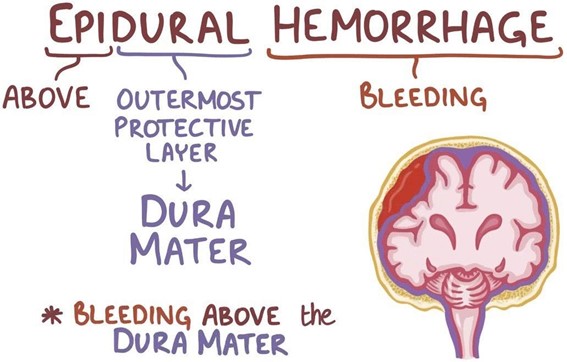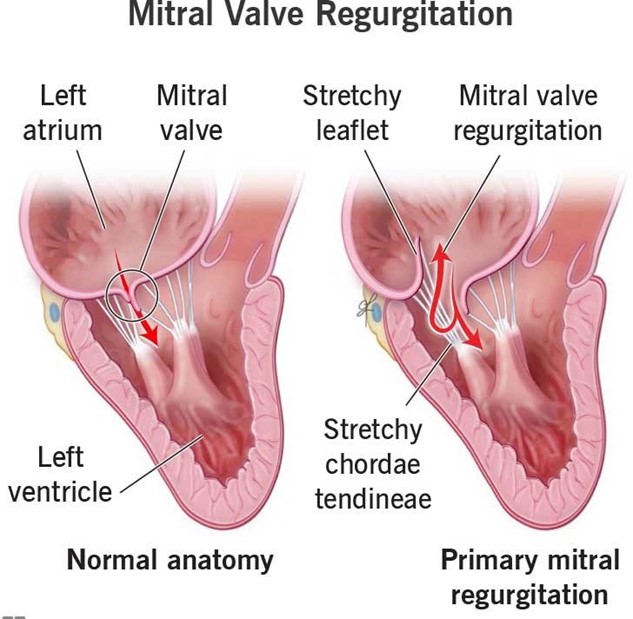A nurse in the emergency department is caring for a client who has an epidural hematoma following a motor-vehicle crash. Which of the following is an expected finding for this client?
Drainage of clear fluid from the ears
Alternating periods of alertness and unconsciousness
Narrowing pulse pressure
Extensive bruising in the mastoid area
The Correct Answer is B
Choice A: Drainage of clear fluid from the ears is not an expected finding for a client who has an epidural hematoma, but rather a sign of a basilar skull fracture, which is a different type of head injury. The clear fluid is cerebrospinal fluid (CSF), which leaks from the brain through the fractured skull.
Choice B: Alternating periods of alertness and unconsciousness is an expected finding for a client who has an epidural hematoma, because it indicates a rapid increase in intracranial pressure (ICP) due to bleeding between the dura mater and the skull. The client may have a brief loss of consciousness at the time of injury, followed by a lucid interval, and then a rapid deterioration of mental status.
Choice C: Narrowing pulse pressure is not an expected finding for a client who has an epidural hematoma, but rather a sign of increased ICP due to any cause. Pulse pressure is the difference between systolic and diastolic blood pressure. As ICP rises, it compresses the brainstem and causes bradycardia and hypertension, resulting in a decreased pulse pressure.
Choice D: Extensive bruising in the mastoid area is not an expected finding for a client who has an epidural hematoma, but rather a sign of a basilar skull fracture, which is a different type of head injury. The bruising is also known as Batle's sign, and it occurs due to blood pooling behind the ear.

Nursing Test Bank
Naxlex Comprehensive Predictor Exams
Related Questions
Correct Answer is C
Explanation
Choice A Reason: This is incorrect because right ventricular failure would cause an increase in right atrial pressure and right ventricular end-diastolic pressure, but not in PAWP, which reflects left atrial pressure and left ventricular end- diastolic pressure.
Choice B Reason: This is incorrect because fluid volume deficit would cause a decrease in PAWP, as there would be less blood volume in the pulmonary circulation.
Choice C Reason: This is correct because mitral regurgitation would cause an increase in PAWP, as the blood would back up into the left atrium and pulmonary veins due to the incompetent mitral valve.
Choice D Reason: This is incorrect because afterload reduction would cause a decrease in PAWP, as there would be less resistance to the left ventricular ejection and less blood volume in the pulmonary circulation.

Correct Answer is B
Explanation
Choice A Reason: This is incorrect because preparing for mechanical ventilation is not the priority nursing intervention, as it is an invasive and potentially harmful procedure that should be reserved for clients who have severe respiratory failure and cannot maintain adequate oxygenation with noninvasive methods.
Choice B Reason: This is correct because administering oxygen via face mask is the priority nursing intervention, as it is a noninvasive and effective way to improve oxygenation and reduce hypoxemia in a client who has low PaO2 and SaO2. Oxygen therapy can also decrease the workload of the heart and lungs and prevent further complications.
Choice C Reason: This is incorrect because preparing to administer a sedative is not the priority nursing intervention, as it may worsen the client's respiratory status and mask the signs and symptoms of hypoxemia. Sedatives should be used with caution and only after oxygenation has been optimized.
Choice D Reason: This is incorrect because assessing for indications of pulmonary embolism is not the priority nursing intervention, as it is a diagnostic rather than a therapeutic action. Pulmonary embolism is a possible cause of the client's condition, but it does not address the immediate problem of hypoxemia.
Whether you are a student looking to ace your exams or a practicing nurse seeking to enhance your expertise , our nursing education contents will empower you with the confidence and competence to make a difference in the lives of patients and become a respected leader in the healthcare field.
Visit Naxlex, invest in your future and unlock endless possibilities with our unparalleled nursing education contents today
Report Wrong Answer on the Current Question
Do you disagree with the answer? If yes, what is your expected answer? Explain.
Kindly be descriptive with the issue you are facing.
